TV eye: Muide Éire TG4, January–February 2012 by John Gibney
Published in 20th-century / Contemporary History, Issue 3 (May/June 2012), Reviews, Volume 20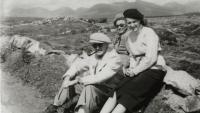
John Ford and Maureen O’Hara on the set of The Quiet Man (1952)—the landscape provides an elemental backdrop.
Muide Éire was a strikingly ambitious history of the depiction of Ireland and the Irish on both big and small screens, from The Quiet Man to The Late Late Show. Written by Ruth Lysaght and directed by Cathal Watters, the four episodes of the series eschewed a chronological narrative and, instead, picked out four themes with which to make sense of its subject-matter: place, character, control and power. It did so in discursive, and lavish, style.The range of material that the series drew upon, from both cinema and television, was frankly staggering. Over 500 clips from over 200 productions were spread over four 40-minute episodes. There was no conventional narrator; the series wove its tapestry both from the footage it used and from a huge range of interviews with a bewildering range of participants, all of whom were given generous space to reflect on what they are a part of, and on its broader relevance. This was made all the more impressive by the fact that it would probably be easier to instance who was not interviewed for the series: there were familiar and unfamiliar names and faces aplenty. It made for an engrossing package.
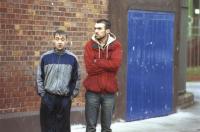
Irish film-makers have sought to depict a range of less well-known alternatives that are equally valid—like the deliberately dystopian Dublin of Adam & Paul (2004). (Element Films)
The four episodes can perhaps be divided into two natural units. The first two, on place and character (áit agus duine), dealt with the manner in which Ireland and its inhabitants have been represented by film-makers. This presents a dichotomy in assessing the manner in which Ireland has been represented, all too often in clichéd terms, by film-makers from abroad as opposed to those from Ireland itself. Muide Éire firmly dealt with the latter rather than the former (which presumably explains the absence of farragos such as Ryan’s Daughter). A key aspect of this was the depiction of the Irish landscape, which can be construed as a character in itself, often in a manner that reflects an older tradition of writing about Ireland: witness, for example, the elemental backdrop to John Ford’s The Quiet Man. Yet, from an internal perspective, Irish film-makers have sought to depict a range of less well-known alternatives that are equally, if not more, valid as being part of the fabric of Irish life: the landscapes of the Irish midlands in Pure Mule or Garage, or the deliberately dystopian Dublin of Adam & Paul.
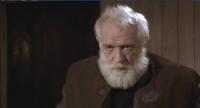
The Bull McCabe (Richard Harris) in Jim Sheridan’s The Field (1990)—an epitome of nationalism or a clichéd urban stereotype of Irish rural life (fearsome stick-waving culchies squabbling over a patch of grass)? (Sovereign Pictures)
Yet one should also be wary of drawing too stark a distinction between Irish and non-Irish film-makers: sometimes there can be a grey area in between. Jim Sheridan states that his conceptualisation of the Bull McCabe in his adaptation of The Field was as an epitome of nationalism. But given its divergence from the play, might Sheridan’s vision also reflect a clichéd urban stereotype of Irish rural life (fearsome stick-waving culchies squabbling over a patch of grass, etc.)? As Fionnuala Flanagan pointed out, however, film-makers are not solely culpable for deploying stereotypes (the colleen, the fool, the drinker, the stoic mammy, the emotionally hamstrung father), if and when they do so; these can only be effective when they are to be found within society at large, and a certain grain of truth may sometimes lurk within them—perhaps even in the sense of internalising a sense of what one is not.
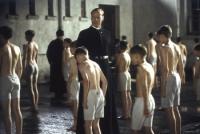
A scene from Song for a Raggy Boy (2003), which went much further in its depiction of the abuse carried out by the Christian Brothers than Cathal Black’s Our Boys (1981), which was banned and not broadcast until 1991. (Fantastic Films)
The second two episodes, on control and power (smacht agus cumhacht), dealt with the manner in which images on screen can articulate, and grapple with, very concrete political and social issues. In 1981 Cathal Black’s Our Boys, detailing the abuse carried out by members of the Christian Brothers, was banned (it would not be broadcast until 1991). Yet Song for a Raggy Boy, released in 2003, went much further in its depiction of appalling brutality of a kind since confirmed in harrowing detail in the Ryan Report (amongst others). Cinema and TV could act as an almost didactic medium—a looking-glass, as it were, in which fictional worlds could be conjured to illuminate a range of unpleasant realities that might otherwise be dodged by what Eamon Dunphy used to call ‘official Ireland’: the plight of Irish emigrants in London, as evoked to distressing effect in Kings, comes to mind. The same can be said of the sexual politics of the 1980s in Margo Harkin’s Hush-a-bye-baby, or the impact of the northern conflict; there is an especially fascinating contribution from the former hunger striker Laurence McKeown, one of the writers of H3, which dealt with the hunger strikes long before the internationally lauded Hunger. Equally, documentaries such as The Pipe and dramas such as Roddy Doyle’s Family (not great, but highly controversial in 1994) could highlight fundamental issues within society in the south—though, as Eamon Morrissey rather cheekily observes, all publicity was more often than not good publicity; a surprising omission in that regard was The Passion of St Tibulius.
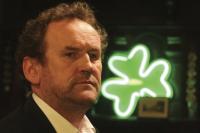
Joe (Colm Meaney) in Kings (2007), in which the plight of Irish emigrants in London is evoked to distressing effect. (New Grange Pictures)
The series did not reach any pat conclusion; rather, it served almost as a montage exploring, quite elegantly and unobtrusively, Ireland’s relationship with the defining medium of the twentieth century. It also exposed a richness and complexity to Irish cinema and TV that might easily be overlooked, given the extent to which such things are taken for granted as part of the backdrop of modern life. And this brings us to another question, for surely Muide Éire is as much a part of its subject-matter as a meditation on it. One must question the rather arrogant suggestion, made by one contributor, that Irish-language programming can push the boundaries of what can be depicted on screen, as its natural constituency is somehow more open-minded than the Anglophone public. An obvious response is that Irish-language programming can get away with more because lower viewing figures ensure that productions as Gaeilge can slip in under the radar. This begs a further question: why is TG4 the leading forum for documentary programming on this island? That fact is a glowing testament to TG4’s dynamism, but it is also surely an indictment of its more generously funded public service counterparts on either side of the border. It is difficult to do justice to this series in a relatively brief review. If there is a criticism to be made, it is that it almost tries to include too much; an extra episode (or two) could easily have been justified. Hopefully it will appear on DVD, as this exceptionally rich series would reward another viewing. Suffice it to say that Muide Éire is, quite simply, one of the very best Irish documentaries to have appeared anywhere in recent years. HI.
















